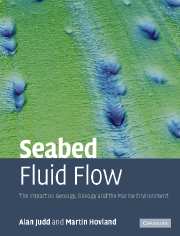Book contents
- Frontmatter
- Contents
- Preface
- Acknowledgements
- Note on the accompanying website
- List of maps on the accompanying website
- List of contributed presentations on the accompanying website
- 1 Introduction to seabed fluid flow
- 2 Pockmarks, shallow gas, and seeps: an initial appraisal
- 3 Seabed fluid flow around the world
- 4 The contexts of seabed fluid flow
- 5 The nature and origins of flowing fluids
- 6 Shallow gas and gas hydrates
- 7 Migration and seabed features
- 8 Seabed fluid flow and biology
- 9 Seabed fluid flow and mineral precipitation
- 10 Impacts on the hydrosphere and atmosphere
- 11 Implications for man
- References
- Index
8 - Seabed fluid flow and biology
Published online by Cambridge University Press: 14 October 2009
- Frontmatter
- Contents
- Preface
- Acknowledgements
- Note on the accompanying website
- List of maps on the accompanying website
- List of contributed presentations on the accompanying website
- 1 Introduction to seabed fluid flow
- 2 Pockmarks, shallow gas, and seeps: an initial appraisal
- 3 Seabed fluid flow around the world
- 4 The contexts of seabed fluid flow
- 5 The nature and origins of flowing fluids
- 6 Shallow gas and gas hydrates
- 7 Migration and seabed features
- 8 Seabed fluid flow and biology
- 9 Seabed fluid flow and mineral precipitation
- 10 Impacts on the hydrosphere and atmosphere
- 11 Implications for man
- References
- Index
Summary
Perhaps the most provocative consequence of the discovery of seafloor hydrothermal vents is the suggestion that these vents may have been the site where life originated.
Van Dover, 2000The most unexpected and spectacular find of the detailed pockmark surveys described in Chapter 2 was the localised increase in biological activity. Since then many deep-water sites of seabed fluid flow have been shown to support rich ecosystems. We now take a more detailed look at the ecology of seeps. First we consider petroleum seeps (in both shallow and deep waters), groundwater flows, hot springs, and hydrothermal vents. It is the latter that have received the greatest attention from the marine research community, but the other habitats are also interesting and important. We also pay attention to carbonate reefs and mounds, and their fauna, as they seem to be unusual and particularly noteworthy. In the second section we consider specific aspects of the foodwebs associated with seabed fluid flow in these contexts. We then take a broader view of the ecology of seeps and their significance to marine biology. We conclude by reminding ourselves that seep-related communities are not new, but have been present for a considerable period of geological time. Were they the pioneers of life on the surface of our planet?
- Type
- Chapter
- Information
- Seabed Fluid FlowThe Impact on Geology, Biology and the Marine Environment, pp. 248 - 289Publisher: Cambridge University PressPrint publication year: 2007



